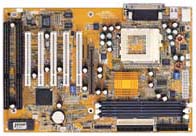Gigabyte GA-6BX7 i440BX ATX Socket-370
by Mike Andrawes on June 1, 1999 1:49 AM EST- Posted in
- Motherboards
Gigabyte is one of those motherboard manufacturers that is extremely well known in some circles, but completely unheard of in others. Quite an odd situation, but one that happens quite often when a motherboard manufacturer makes quality products, but remains relatively low key in the industry. In this situation, the manufacturer often becomes sort of a well kept secret among those who stumble upon them.
Gigabyte is one of those well kept secrets, and has actually been around longer than many more popular manufacturers. Those that have been using their boards for years know that they generally put out high quality products that are mostly trouble free. These users have helped spread the word about Gigabyte, and as that word has spread, more and more vendors have picked up their products. With vendor support and an improved web/newsgroup presence, Gigabyte is poised to take on the big boys like Asus, Abit, AOpen, and Tyan - a much tougher challenge. The first of their boards that we looked at, the BX2000, offerred a dual BIOS setup as its claim to fame. Let's see how they fare with the second of their boards to come through the AnandTech test labs - the GA-6BX7.
New Anand Tech Report Card Rating 88/B
Do not compare newer ratings to older ones, the newer ratings are much more aggressive
| CPU Interface | Socket-370 |
| Chipset | Intel i440BX |
| L2 Cache | N/A (on-chip) |
| Form Factor | ATX |
| Bus Speeds |
66 / 75 / 83 |
| Clock Multipliers | 3x - 9x |
| Voltages Supported | Auto Detect |
| Memory Slots | 3 168pin DIMM Slots |
| Expansion Slots | 1
AGP Slot 5 PCI Slots (5 Full Length) 2 ISA Slot (1 Shared / 2 Full Length) |
| BIOS | Award 4.51PG |
The Good
The GA-6BX7 is a much more traditional motherboard where Gigabyte decided to focus primarily on the board itself rather than gimmicks. Just looking at the GA-6BX7, it's clear that they set out to follow all current specifications and standards set forth for motherboard design. The one that catches the eye first is the color coded ATX ports on the back of the board for PC99 compliance. Almost every new motherboard will start including this nifty little "feature." While it does little for the tweaker, it certainly does make it easier for grandma to setup her computer using color coded plugs. It's no longer just for Packard Bell's ;).
The ATX specification is also closely followed with all major components strategically placed to minimize cable clutter and provide the most room to work around the board. All HDD/FDD connectors are located where they should be, right at the front of the board, so that no cables are forced to run over the CPU and/or memory. The second IDE connector is conveniently colored white (as opposed to the black of the first IDE channel) to make identification at a glance possible. The ATX power connector is right behind the DIMM slots, but still far enough forward to allow adequate air flow over the CPU from the power supply. The board uses a standard ATX format, but is fairly short - just a bit longer than an ISA slot - and should fit just fine in any ATX case.
Gigabyte was also wise enough to offer a 5/2/1 (PCI/ISA/AGP) configuration that is virtually standard on newer Slot-1 i440BX, but lacking on the majority of Socket-370 models. The three available DIMM slots are pretty much standard fare for an i440BX board. Three fan connectors are available - two next to the CPU socket, and one at the front of the board. Ten 1200uF capacitors are located immediately around the CPU socket with several 330uF capacitors placed all over the board. A variety of generic connectors are used for I/O and expansion slots, but a high quality AMP connector is used on the CPU socket. DIMM slots are also no-name, but seem to be quite strong and as good as any others available today.
The stability of the GA-6BX7 was top notch in both non-overclocked and overclocked situations. While not quite reaching the level of the Intel SE440BX, it was about the same as the AOpen AX6BC, which is to say excellent. Performance was similarly exemplary, outperforming the average i440BX board by more than the normal 5% variation among such boards in both Winstone 99 and Quake 2 demo1.dm2.











0 Comments
View All Comments